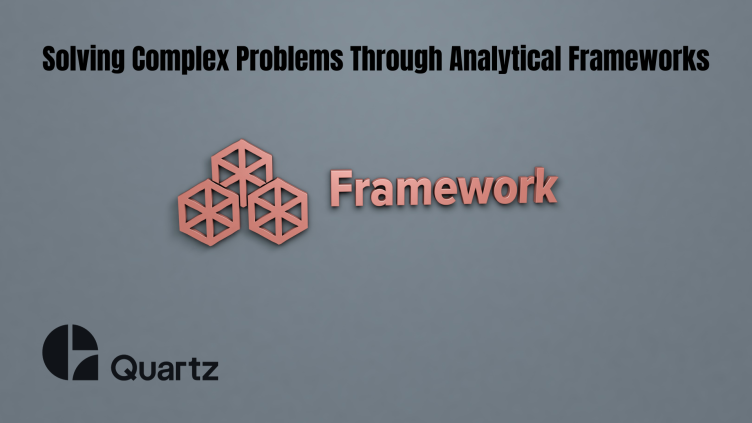Solving Complex Problems Through Analytical Frameworks
January 16, 2024
Business Intelligence

Navigating the labyrinth of business challenges requires more than intuition and experience; it demands a structured, analytical approach. This is where analytical frameworks come into play, serving as navigational beacons in the often-turbulent sea of corporate decision-making. They are not just tools but strategic allies, enabling businesses to dissect complex problems, uncover underlying causes, and chart courses towards practical solutions.
In this article, we delve deep into the world of these frameworks, exploring their role, effectiveness, and application in transforming business challenges into opportunities for growth and innovation.
Analytical frameworks stand at the crossroads of data-driven insight and strategic action, offering a systematic way to untangle the knots of complicated business issues. From startups grappling with market entry to established corporations steering through organisational changes, these frameworks are the silent engines powering successful strategies and decisions.
Our journey through this article will take us through various frameworks, each a lens through which businesses can view and solve their unique challenges. We will offer practical advice on choosing and applying these tools, backed by real-world examples that showcase their transformative power. In doing so, we aim to arm management consultants and business leaders with the knowledge and skills to turn analytical frameworks into catalysts for change and success.
The Role and Benefits of Analytical Frameworks
At the core, analytical frameworks are conceptual models that simplify complex realities into manageable components. These tools help dissect a problem into its essential elements, making it easier to analyse and understand. Their structured nature ensures that no aspect of the problem is overlooked, which is crucial in developing a comprehensive strategy. These frameworks facilitate focused analysis by breaking down problems into smaller parts, leading to more accurate solutions.
The use of these frameworks leads to improved decision-making processes. They offer a clear path to dissect information, weigh different variables, and evaluate possible outcomes. Moreover, they bring clarity and efficiency to problem-solving processes, which are invaluable in fast-paced business environments.
Exploring Popular Analytical Frameworks
Several analytical frameworks are popular in the business world, each with its unique focus and application:
SWOT Analysis:
This framework helps assess internal (Strengths and Weaknesses) and external (Opportunities and Threats) factors influencing a project or business venture. It’s a versatile tool used in strategic planning and decision-making.
Porter’s Five Forces:
Focusing on industry analysis, this framework examines competitive rivalry, supplier power, buyer power, threat of substitution, and threat of new entry. It’s crucial for understanding market dynamics and strategic positioning.
McKinsey 7S Framework:
This model analyses organisational effectiveness by looking at seven internal aspects: strategy, structure, systems, shared values, skills, style, and staff. It’s essential for organisational change and alignment.
PESTLE Analysis:
This tool examines external factors affecting a business – Political, Economic, Social, Technological, Legal, and Environmental influences. It’s vital for market analysis and strategic planning.
The Five Whys:
A simple yet powerful tool for root cause analysis, this method repeatedly asks “Why?” until the underlying problem is identified. It’s effective in troubleshooting and problem resolution.
Applying Frameworks: Practical Tips
While frameworks offer structured paths, their effectiveness depends on their application. Here are some tips for using analytical frameworks:
Tailor the Framework:
Adapt the framework to fit the problem’s specific context. No two business challenges are identical, so customisation is critical.
Comprehensive Data Collection:
Gather all relevant data and information. Accurate and comprehensive data is the backbone of practical analysis.
Involve Diverse Perspectives:
Engage different stakeholders in the analysis process. Diverse perspectives enrich the analysis and lead to holistic solutions.
Balance with Creativity:
While frameworks provide structure, they should not stifle creativity. Encourage innovative thinking within the framework’s boundaries.
Continuous Evaluation:
Assess the effectiveness of the chosen framework and be open to adjustments based on new insights or changing business environments.
Case Studies: Frameworks in Action
These examples illustrate the practical application of these frameworks:
- A technology firm used SWOT analysis to navigate a rapidly shifting market, identifying new opportunities for innovation while mitigating potential threats from emerging competitors.
- An e-commerce company applied Porter’s Five Forces to understand its competitive industry, which guided its strategy for customer retention and market expansion.
- A multinational corporation utilised the McKinsey 7S Framework during a significant restructuring, ensuring alignment across various departments and global offices.
Overcoming Potential Pitfalls
Despite their utility, analytical frameworks are not without limitations. Over-reliance on these models can lead to tunnel vision, ignoring elements that do not fit into the structured format. It is essential to balance framework-driven analysis with creative and critical thinking. Frameworks are guides, not absolute answers. Incorporating qualitative insights and fostering an environment that values innovative thinking is crucial in overcoming these limitations.
Charting the Path Forward
Analytical frameworks are more than problem-solving structures—they are guides for businesses in unknown territories. They combine critical thinking and structured analysis, offering clarity, direction, and innovation in complex situations.
Through various frameworks, such as SWOT and Porter’s Five Forces, we discover the diverse nature of business challenges and the customized solutions they require. The key to unlocking these frameworks’ potential is applying them skillfully and adapting them to each business context.
For consultants and strategists, these frameworks are not just tools but dialogue partners—a way to interact with problems, data, and complexities. They are the foundations for strategies that solve problems, create opportunities, and foster innovation.
To navigate the future, businesses and consultants must remember that analytical frameworks are powerful when applied flexibly, balanced with creativity, and enriched by diversity. They are the agents that can turn analytical insights into strategic actions, leading businesses to growth and success.
As we end, let’s appreciate these frameworks not just as methods but as essential elements of our strategic toolkit. With these tools, businesses and consultants can chart their way forward, overcoming challenges in a complex world.
